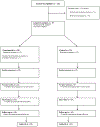A parent-directed language intervention for children of low socioeconomic status: a randomized controlled pilot study
- PMID: 26041013
- PMCID: PMC10835758
- DOI: 10.1017/S0305000915000033
A parent-directed language intervention for children of low socioeconomic status: a randomized controlled pilot study
Abstract
We designed a parent-directed home-visiting intervention targeting socioeconomic status (SES) disparities in children's early language environments. A randomized controlled trial was used to evaluate whether the intervention improved parents' knowledge of child language development and increased the amount and diversity of parent talk. Twenty-three mother-child dyads (12 experimental, 11 control, aged 1;5-3;0) participated in eight weekly hour-long home-visits. In the experimental group, but not the control group, parent knowledge of language development increased significantly one week and four months after the intervention. In lab-based observations, parent word types and tokens and child word types increased significantly one week, but not four months, post-intervention. In home-based observations, adult word tokens, conversational turn counts, and child vocalization counts increased significantly during the intervention, but not post-intervention. The results demonstrate the malleability of child-directed language behaviors and knowledge of child language development among low-SES parents.
Figures





Similar articles
-
Early Parental Knowledge and Parent-Child Conversations Promote Preschool Language Skills: A Randomized Controlled Trial.Acad Pediatr. 2024 Sep-Oct;24(7):1062-1067. doi: 10.1016/j.acap.2024.06.015. Epub 2024 Jun 27. Acad Pediatr. 2024. PMID: 38944150 Clinical Trial.
-
Impacts of a shared book-reading intervention for Italian-speaking children with developmental language disorder.Int J Lang Commun Disord. 2019 Jul;54(4):565-579. doi: 10.1111/1460-6984.12460. Epub 2019 Feb 7. Int J Lang Commun Disord. 2019. PMID: 30729644
-
Parent-mediated interventions for promoting communication and language development in young children with Down syndrome.Cochrane Database Syst Rev. 2018 Oct 15;10(10):CD012089. doi: 10.1002/14651858.CD012089.pub2. Cochrane Database Syst Rev. 2018. PMID: 30321454 Free PMC article. Review.
-
Project ASPIRE: Spoken Language Intervention Curriculum for Parents of Low-socioeconomic Status and Their Deaf and Hard-of-Hearing Children.Otol Neurotol. 2016 Feb;37(2):e110-7. doi: 10.1097/MAO.0000000000000931. Otol Neurotol. 2016. PMID: 26756142 Clinical Trial.
-
Communication interventions for autism spectrum disorder in minimally verbal children.Cochrane Database Syst Rev. 2018 Nov 5;11(11):CD012324. doi: 10.1002/14651858.CD012324.pub2. Cochrane Database Syst Rev. 2018. PMID: 30395694 Free PMC article.
Cited by
-
ALICE: An open-source tool for automatic measurement of phoneme, syllable, and word counts from child-centered daylong recordings.Behav Res Methods. 2021 Apr;53(2):818-835. doi: 10.3758/s13428-020-01460-x. Behav Res Methods. 2021. PMID: 32875399 Free PMC article.
-
Language learning, socioeconomic status, and child-directed speech.Wiley Interdiscip Rev Cogn Sci. 2016 Jul;7(4):264-75. doi: 10.1002/wcs.1393. Epub 2016 May 19. Wiley Interdiscip Rev Cogn Sci. 2016. PMID: 27196418 Free PMC article. Review.
-
Auditory chaos classification in real-world environments.Front Digit Health. 2023 Dec 21;5:1261057. doi: 10.3389/fdgth.2023.1261057. eCollection 2023. Front Digit Health. 2023. PMID: 38178925 Free PMC article.
-
The impact of a specialist home-visiting intervention on the language outcomes of young mothers and their children: a pragmatic randomised controlled trial.BMC Psychol. 2022 Sep 23;10(1):224. doi: 10.1186/s40359-022-00926-1. BMC Psychol. 2022. PMID: 36151554 Free PMC article. Clinical Trial.
-
Variations in the Home Language Environment and Early Language Development in Rural China.Int J Environ Res Public Health. 2021 Mar 6;18(5):2671. doi: 10.3390/ijerph18052671. Int J Environ Res Public Health. 2021. PMID: 33800901 Free PMC article.
References
-
- Abraham C & Michie S (2008). A taxonomy of behavior change techniques used in interventions. Health Psychology 27(3), 379–87. - PubMed
-
- Ajzen I (1996). The directive influence of attitudes on behavior. In Gollwitzer PM & Bargh JA (eds), The psychology of action: linking cognition and motivation to behavior, 385–403. New York, NY: Guilford Press.
-
- Algozzine B, Wang C & Boukhtiarov A (2011). A comparison of progress monitoring scores and end-of-grade achievement. New Waves-Educational Research & Development 14(1), 3–21.
-
- Aronson J, Fried CB & Good C (2002). Reducing the effects of stereotype threat on African American college students by shaping theories of intelligence. Journal of Experimental Social Psychology 38(2), 113–25.
-
- Baxendale J & Hesketh A (2003). Comparison of the effectiveness of the Hanen ParentProgramme and traditional clinic therapy. International Journal of Language & Communication Disorders/Royal College of Speech & Language Therapists 38(4), 397–415. - PubMed
Grants and funding
LinkOut - more resources
Full Text Sources
Medical
Miscellaneous

